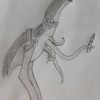HOME | DD
 Sheather888 — The Ping-Tu
Sheather888 — The Ping-Tu

Published: 2020-03-01 06:45:24 +0000 UTC; Views: 16775; Favourites: 267; Downloads: 0
Redirect to original
Description
Support me on patreon to see more weird stuff, or get your own monthly art request! www.patreon.com/sheatherius
Another idea requested by www.deviantart.com/grazatt , living in the same universe as the last mammal.
~~~
The Ping-Tu were a race of sapient, civilization-building caterpillars which lived on Earth for approximately five million years, from 495 to around 500 million years hence. Evolved from a line that lost its metamorphosis to a moth and became sexually mature in its larval stage over 400 million years earlier, they belonged to a wider clade of insects known as which abandoned their hard exoskeletons in favor of retaining the caterpillar's fluid-based hydrostatic skeletons. This, combined with the evolution complex pumping system of air sacs connected to their spiracles, let them grow to enormous sizes for land arthropods - the Ping-tu weighed about five pounds each, but some extinct grazing species, which kept low to the ground, grew to over one hundred pounds. These huge caterpillars evolved in the aftermath of a massive gamma ray burst 150 million years ago that wiped out 99% of terrestrial vertebrates. They evolved six eyes from the primitive light receptors of the ancestral caterpillar, and became centaur-like, walking on their lobe-like false legs and adapting their six true legs as manipulators.
In the millions of years following, surviving land vertebrates - a few species of rodent-like burrowing canid, legless lizards and moles - recolonized the surface and displaced the largest and most cumbersome megafaunal caterpillars. The smaller ancestors of the Ping-tu, however, survived by being more resourceful. They fed on seeds instead of grass and began to collect and store stashes of food, carrying it in a highly elongated, hand-like leg pair, and they became more intelligent in order to memorize the location of hidden resources in the future. To avoid predators they also became social, living in communal nests woven of silk (which they produced from glands along their jaws) in the sedge-trees that now dominated the land. For millions of years the Ping-tu lived this way; highly intelligent, they developed culture and myth, but their lifestyle - gathering seeds, bringing them to the nest, and repairing and building onto their silken homes - was simple, and they did not progress beyond a neolithic level of technology. It was not for four million years, when the planet began to experience a dramatic shift in climate as the continents collided into a supercontinent and much of the forest was replaced by arid deserts, that the Ping-tu began to adapt new behaviors that would ultimately lead them into their own industrial revolution. As they adapted to harsher conditions, they widened their diets and tamed fire in order to render animal flesh more edible to their herbivore guts; from there, they smelt metals. In only a few thousand years the Ping-tu had replaced their vanished forest homes with artificial forests of metal and plastic, high above the shifting desert sands and connected with highways of their own silk - a material, pound for pound, stronger than any metal - across which the scuttling worms climbed around their artificial world. The Ping-tu learned to pump up water from deep under the Earth and, when even this became salty, to desalinate the sea. But in powering their world, the Ping-tu were unaware of the effects they would have on climate. Greenhouse gases warmed their already unstable world further, and soon the Ping-tu could only survive in climate-controlled indoor cities. They built enormous coolers to remove heat from their systems, relying on chlorofluorocarbon air conditioning to chill their indoor environments - unaware that these chemical coolants would rapidly destroy the Earth's ozone layer, rendering life outside their climate-controlled domes not only hostile, but impossible, as deadly solar radiation now baked the surface of the planet at levels high enough to give any creature out during daylight instant cancer. It took only a single power outage, resulting from strong winds, to kill off the remaining members of the species, who fried in hours without artificial cooling.
The Earth never fully recovered from the Ping-tu's destructive reign. A few small vertebrates and other insects persisted in the desert, surviving underground, but conditions would only get harder. A few million years longer, and plate tectonics began to halt. The carbon cycle began to break down without the influx of Co2 from volcanism, and a vast majority of land plants died. The last vertebrates on planet Earth were hard-shelled lizards; the last of all animals small beetles with mirrored shells that reflected the sun's rays. Though a few hardy grasses survived as long as 650 million years hence, Earth was a lifeless desert world within 25 million more.
Related content
Comments: 23

👍: 2 ⏩: 0

👍: 0 ⏩: 0

👍: 3 ⏩: 0

Why does the wormmy boi look like it's shrugging?
Also cool design and interesting description.
👍: 1 ⏩: 0

👍: 1 ⏩: 2

👍: 2 ⏩: 0

The thing about sapient species is that they tend to cause mass extinctions. Sheather is just trying to avoid that.
👍: 1 ⏩: 1

👍: 5 ⏩: 0

👍: 0 ⏩: 1

No, your project is a pile of hot garbage that steals people's art.
👍: 7 ⏩: 1

It's funny because it's true.
👍: 1 ⏩: 0

I'd think that underground aquifers would be a refuge.
👍: 0 ⏩: 0

👍: 0 ⏩: 0

👍: 2 ⏩: 0

When I first saw this, I thought it was a velvet worm.
👍: 0 ⏩: 0

👍: 0 ⏩: 1

There is another creature from the same TL but millions of years earlier. I don't know if he has posted it yet
👍: 0 ⏩: 1

👍: 0 ⏩: 0

Wish I had some of these in summer to eat all the aphids!
👍: 0 ⏩: 0

damn, sapient caterpillars... very imaginative
👍: 0 ⏩: 0




















